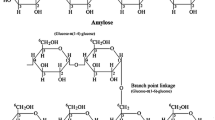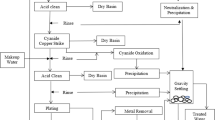Abstract
In the present work, electrocoagulation method was employed using iron/aluminium electrodes for COD removal in the treatment of landfill leachate. The process was optimized with variables such as initial pH, applied current, initial COD and electrolysis time experimentally varied as per CCD design to know their influence on chosen response variables viz. COD removal efficiency and electrical energy consumption. The optimum conditions found were pH 5, applied current 0.5 A, initial COD concentration 5450 ppm and application time 9 min to achieve 64.25% efficiency with 0.59 W hour per gram removal of COD. The results prove that electrocoagulation process could be suitably used as an effective method for treatment of leachate. Operating cost of optimized condition was figured out as Indian rupee 0.211 (equivalent to 0.0028 US $) per gram of COD removed.




Similar content being viewed by others
References
Akbal F, Camci S (2011) Copper, Chromium and Nickel removal from metal plating wastewater by electrocoagulation. Desalination 269(1–3):214–222
Asaithambi P, Aziz A, Raman A, Wan AZ, Daud MABW (2016) Integrated ozone—electrocoagulation process for the removal of pollutant from industrial effluent: Optimization through response surface methodology. Chem Eng Process Process Intensif 105:92–102
Aziz A, Basheer F, Sengar A, Khan SU, Farooqi IH (2019) Biological wastewater treatment (anaerobic-aerobic) technologies for safe discharge of treated slaughterhouse and meat processing wastewater. Sci Total Environ 686:681–708
Babbar P, Verma S, Mehmood G (2017) Groundwater contamination from non-sanitary landfill sites—a case study on the Ghazipur Landfill Site, Delhi ( India ). Int J Appl Environ Sci 12(11):1969–1991
Cañizares P, Jiménez C, Martínez F, Rodrigo MA, Saez C (2009) The pH as a key parameter in the choice between coagulation and electrocoagulation for the treatment of wastewaters. J Hazardous Mater 163(1):158–164
Chen G (2004) Electrochemical technologies in wastewater treatment. Sep Purif Technol 38(1):11–41
Drogui P, BlaisJF MG (2008) Review of electrochemical technologies for environmental applications. Recent Patents Eng 1(3):257–272
Elwakeel KZ, Elgarahy AM, Khan ZA, Almughamisi MS, Al-Bogami AS (2020) Perspectives regarding metal/mineral-incorporating materials for water purification: with special focus on Cr (vi) removal. Mater Adv 1(6):1546–1574
Feng C, Sugiura N, Shimada S, Maekawa T (2003) Development of a high performance electrochemical wastewater treatment system. J Hazard Mater 103(1–2):65–78
Feng J, Sun Y, Zheng Z, Zhang J, Li S, Tian Y (2007) Treatment of tannery wastewater by electrocoagulation. J Environ Sci 19(12):1409–1415
Ferronato N, Torretta V (2019) Waste mismanagement in developing countries: a review of global issues. Int J Environ Res Public Health 16(6):1060
Golder A, Kumar H, Samanta A, Ray S (2010) Colour diminution and COD reduction in treatment of coloured effluent by Electrocoagulation. Int J Environ Eng 2(1–3):228–238
Gotvajn AŽ, Tišler T, Zagorc-Končan J (2009) Comparison of different treatment strategies for industrial landfill leachate. J Hazard Mater 162(2–3):1446–1456
Hashim KS, Al Khaddar R, Jasim N, Shaw A, Phipps D, Kot P, Pedrola MO, Alattabi AW, Abdulredha M, Alawsh R (2019) Electrocoagulation as a greentechnology for phosphate removal from river water. Sep Purif Technol 210:135–144
Ibrahim S, El-Liethy MA, Elwakeel KZ, Hasan MA, Al Zanaty AM, Kamel MM (2020) Role of identified bacterial consortium in treatment of Quhafa wastewater treatment plant influent in Fayuom. Egypt Environ Monit Assess 192(3):1–10
Jing G, Ren S, Gao Y, Sun W, Gao Z (2020) Electrocoagulation: a promising method to treat and reuse mineral processing wastewater with high COD. Water 12(2):595
Jotin R, Ibrahim S, Halimoon N (2012) Electro coagulation for removal of chemical oxygen demand in sanitary landfill leachate. Int J Environ Sci 3(2):921–930
Kamaruddin MA, Yusoff MS, Aziz HA, Hung YT (2015) Sustainable treatment of landfill leachate. Appl Water Sci 5(2):113–126
Kamaruddin MA, Yusoff MS, Rui LM, Isa AM, Zawawi MH, Alrozi R (2017) An overview of municipal solid waste management and landfill leachate treatment: Malaysia and Asian perspectives. Environ Sci Pollut Res 24(35):26988–27020
Kang KH, Shin HS, Park H (2002) Characterization of humic substances present in landfill leachates with different landfill ages and its implications. Water Res 36(16):4023–4032
Khan SU, Noor A, Farooqi IH (2015) GIS application for groundwater management and quality mapping in rural areas of District Agra, India. Int J Water Resour Arid Environ 4(1):89–96
Khan SU, Islam DT, Farooqi IH, Ayub S, Basheer F (2019) Hexavalent chromium removal in an electrocoagulation column reactor: process optimization using CCD, adsorption kinetics and pH modulated sludge formation. Process Saf Environ Prot 122:118–130
Khan SU, Farooqi IH, Usman M, Basheer F (2020a) Energy efficient rapid removal of arsenic in an electrocoagulation reactor with hybrid Fe/Al electrodes: process optimization using CCD and kinetic modeling. Water 12(10):2876
Khan SU, Asif M, Alam F, Khan NA, Farooqi IH (2020b) Optimizing fluoride removal and energy consumption in a batch reactor using electrocoagulation: a smart treatment technology. In: Ahmed S, Abbas S, Zia H (eds) Smart cities—opportunities and challenges. Lecture notes in civil engineering, vol 58. Springer, Singapore, pp 767–778
Khan SU, Mahtab MS, Farooqi IH (2021) Enhanced lead (II) removal with low energy consumption in an electrocoagulation column employing concentric electrodes: process optimisation by RSM using CCD. Int J Environ Anal Chem. https://doi.org/10.1080/03067319.2021.1873304
Labanowski J, Pallier V, Feuillade-Cathalifaud G (2010) Study of organic matter during coagulation and electrocoagulation processes: application to a stabilized landfill leachate. J Hazardous Mater 179(1–3):166–172
Mahtab MS, Farooqi IH (2020) UV-TiO2 process for landfill leachate treatment: optimization by response surface methodology. Int J Res Eng Appl Manag 5(12):14–18
Mahtab MS, Islam DT, Farooqi IH (2020) Optimization of the process variables for landfill leachate treatment using Fenton based advanced oxidation technique. Eng Sci Technol Int J. https://doi.org/10.1016/j.jestch.2020.08.013
Mateen QS, Khan S, Islam DT, Khan NA (2020) Copper (II) removal in a column reactor using electrocoagulation: parametric optimization by response surface methodology using central composite design. Water Environ Res 92(9):1350–1362
Minelgaitė A, Liobikienė G (2019) Waste problem in European Union and its influence on waste management behaviours. Sci Total Environ 667:86–93
Mirji G, Kalburgi PB (2015) Application of electrocoagulation mechanism for COD removal of dairy wastewater. Int J Mech Prod Eng 6(11):86–88
Mollah MYA, Parga JR, Schennach R, Cocke DL (2001) Electrocoagulation (EC)—science and applications. J Hazard Mater 29–41(84):29–41
Moraes PB, Bertazzoli R (2005) Electrodegradation of landfill leachate in a flow electrochemical reactor. Chemosphere 58(1):41–46
Moreno-Casillas HA, Cocke DL, Gomes JAG, Morkovasky P, Parga JR, Peterson E (2007) Electrocoagulation mechanism for COD removal. Sep Purif Technol 56(2):204–211
Naje AS, Chelliapan S, Zakaria Z, Abbas SA (2016) Electrocoagulation using a rotated anode: a novel reactor design for textile wastewater treatment. J Environ Manage 176:34–44
Ozturk I, Altinbas M, Koyuncu I, Arikan O, Gomec-Yangin C (2003) Advanced physico-chemical treatment experiences on young municipal landfill leachates. Waste Manage 23(5):441–446
Öztürk T, Özcan ÖF (2020) Effectiveness of electrocoagulation and chemical coagulation methods on paper industry wastewaters and optimum operating parameters. Sep Sci Technol. https://doi.org/10.1080/01496395.2020.1805465
Pisarevsky AM, Polozova IP, Hockridge PM (2005) Chemical oxygen demand. Russ J Appl Chem 78(1):101–107
Press AF (2020) Garbage mountain at Delhi’s Ghazipur landfill to rise higher than Taj Mahal by 2020—India news—Hindustan Times, Hindustan Times. Available at: https://www.hindustantimes.com/india-news/garbage-mountain-at-delhi-s-ghazipur-landfill-to-rise-higher-than-taj-mahal-by-2020/story-RC0kwZdUmdHHfDs3rJGngI.html (Accessed: 14 October 2020)
Ren Q, Yu Y, Zhu S, Bian D, Huo M, Zhou D, Huo H (2017) Characterization of a novel micro-pressure swirl reactor for removal of chemical oxygen demand and total nitrogen from domestic wastewater at low temperature. Biodegradation 28(2):145–157
Sharma KD, Jain S (2019) Overview of municipal solid waste generation, composition, and management in India. J Environ Eng 145(3):04018143
Tak BY, Tak BS, Kim YJ, Park YJ, Yoon YH, Min GH (2015) Optimization of color and COD removal from livestock wastewater by electrocoagulation process: application of Box-Behnken design (BBD). J Ind Eng Chem 28:307–315
Thirugnanasambandham K, Sivakumar V, Maran JP (2015) Evaluation of anelectrocoagulation process for the treatment of bagasse-based pulp and paper industry wastewater. Environ Prog Sustainable Energy 34:411–419
Veli S, Ozturk T, Dimoglo A (2008) Treatment of municipal solid wastes leachate by means of chemical- and electro-coagulation. Sep Purif Technol 61(1):82–88
Author information
Authors and Affiliations
Corresponding author
Ethics declarations
Conflict of interest
The authors declare that they have no known competing financial interests or personal relationships that could have appeared to influence the work reported in this paper.
Additional information
Editorial responsibility: J. Aravind.
Rights and permissions
About this article
Cite this article
Faheem, K., Khan, S.U., Washeem, M. et al. Energy efficient removal of COD from landfill leachate wastewater using electrocoagulation: parametric optimization using RSM. Int. J. Environ. Sci. Technol. 19, 3625–3636 (2022). https://doi.org/10.1007/s13762-021-03277-3
Received:
Revised:
Accepted:
Published:
Issue Date:
DOI: https://doi.org/10.1007/s13762-021-03277-3




